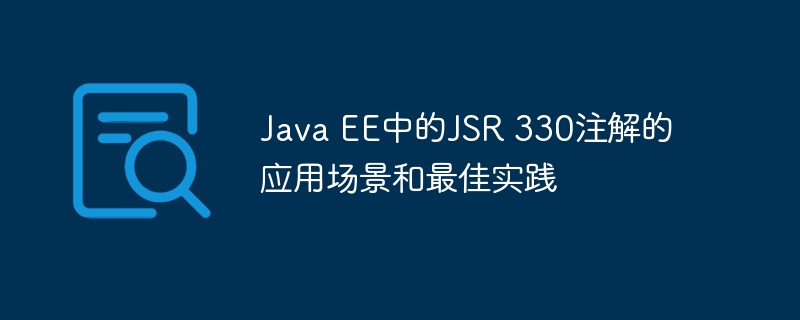JSR 330 annotations are used in Java EE for dependency injection, lifecycle management, scope control, and event-driven programming. Application scenarios include injecting dependencies into components, defining initialization and destruction methods, controlling component lifecycle and scope, and achieving loose coupling based on events. Best practices include following dependency injection principles, using appropriate scoping, avoiding circular dependencies, using lifecycle methods carefully, and leveraging event-driven programming. Practical cases include servlets that use the @Inject annotation to obtain data from the database, where the @PostConstruct and @PreDestroy annotations are used to manage the initialization and destruction of components, thereby simplifying the code and improving testability and maintainability.

Application scenarios and best practices for JSR 330 annotations in Java EE
JSR 330 (Java Specification Request 330) defines Standardized annotations for dependency injection (DI) on the Java platform. It is integrated with the Jakarta EE CDI (Context and Dependency Injection) implementation in Java EE. This article will explore the application scenarios and best practices of JSR 330 annotations in Java EE applications.
Application scenarios
- Dependency injection: JSR 330 annotations (@Inject/@Named) are used to inject dependencies into applications Program components simplify code complexity and maintenance.
- Life cycle management: @PostConstruct and @PreDestroy annotations are used to define the initialization and destruction methods of components.
- Scope control: The @Singleton, @ApplicationScoped, @RequestScoped and @SessionScoped annotations are used to control the lifetime and scope of the component.
- Event-driven programming: @Observes and @Produces annotations are used to define and process events to achieve loosely coupled communication between components.
Best Practices
- Follow dependency injection principles: Use dependency injection whenever possible and avoid hard-coded dependencies.
- Use appropriate scope control: Choose scope control annotations reasonably according to the usage scenario and lifetime of the component.
- Avoid circular dependencies: Ensure that dependencies between components do not form a cycle to prevent application startup failure.
- Use life cycle methods with caution: Use @PostConstruct and @PreDestroy annotations only when necessary to avoid unnecessary overhead.
- Utilize event-driven programming: Make full use of the event mechanism of JSR 330 to achieve loose coupling and scalability between components.
Practical case
Consider a simple Java EE servlet that uses JSR 330 annotations to get data from the database:
import javax.inject.Inject;
public class DataServlet extends HttpServlet {
@Inject
private Dao dao;
@Override
protected void doGet(HttpServletRequest req, HttpServletResponse resp) {
List<Entity> entities = dao.getAllEntities();
// 进一步处理 entities 并响应请求
}
}In In this example, the @Inject annotation injects the implementation of the Dao interface into the servlet, while the @PostConstruct and @PreDestroy annotations are used to manage the initialization and destruction of the dao component. By using JSR 330 annotations, we can simplify the code and improve testability and maintainability.
The above is the detailed content of Application scenarios and best practices of JSR 330 annotations in Java EE. For more information, please follow other related articles on the PHP Chinese website!
 Java JNDI 与 Spring 集成的秘诀:揭秘 Java JNDI 与 Spring 框架的无缝协作Feb 25, 2024 pm 01:10 PM
Java JNDI 与 Spring 集成的秘诀:揭秘 Java JNDI 与 Spring 框架的无缝协作Feb 25, 2024 pm 01:10 PMJavaJNDI与spring集成的优势JavaJNDI与Spring框架的集成具有诸多优势,包括:简化JNDI的使用:Spring提供了抽象层,简化了JNDI的使用,无需编写复杂的JNDI代码。集中管理JNDI资源:Spring可以集中管理JNDI资源,便于查找和管理。支持多种JNDI实现:Spring支持多种JNDI实现,包括JNDI、JNP、RMI等。无缝集成Spring框架:Spring与JNDI的集成非常紧密,无缝集成Spring框架。如何集成JavaJNDI与Spring框架集成Ja
 Web开发的Java技术栈:了解Java EE、Servlet、JSP、Spring等常用于Web开发的技术Dec 26, 2023 pm 02:29 PM
Web开发的Java技术栈:了解Java EE、Servlet、JSP、Spring等常用于Web开发的技术Dec 26, 2023 pm 02:29 PMJavaWeb开发技术栈:掌握JavaEE、Servlet、JSP、Spring等用于Web开发的技术随着互联网的迅速发展,在当今的软件开发领域,Web应用的开发已经成为一种非常重要的技术需求。而Java作为一种广泛应用的编程语言,其在Web开发领域也有着重要的地位。JavaWeb开发技术栈涉及多项技术,如JavaEE、Servlet、JSP、Spr
 比较分析WebLogic和Tomcat在不同应用场景下的适用性Dec 28, 2023 am 08:45 AM
比较分析WebLogic和Tomcat在不同应用场景下的适用性Dec 28, 2023 am 08:45 AMWebLogic和Tomcat是两个常用的Java应用服务器,它们都能够提供Java应用程序的运行环境和支持。然而,它们在功能和适用场景上有一些区别。本文将对WebLogic和Tomcat进行比较分析,以便开发者能够根据自身需求选择最合适的应用服务器。首先,WebLogic是一个功能强大的企业级应用服务器,它提供了许多高级功能,如集群、负载均衡、高可用性和故
 提升技能,Java工程师需要获得哪些专业证书?Feb 02, 2024 pm 06:00 PM
提升技能,Java工程师需要获得哪些专业证书?Feb 02, 2024 pm 06:00 PM随着互联网和信息技术的不断发展,Java工程师已经成为IT行业中的核心职位之一。作为一个Java工程师,如果想提升自己的技能水平,拥有一些专业证书是非常重要的。本文将介绍一些常见的Java工程师需要考取的专业证书。OracleCertifiedProfessional,JavaSEProgrammer(OCP-JP)Oracle公司提供的Java
 Java JAX-RS 的艺术:探索其细微差别Feb 29, 2024 pm 06:01 PM
Java JAX-RS 的艺术:探索其细微差别Feb 29, 2024 pm 06:01 PM引言JavaapiforRESTfulWEBServices(JAX-RS)是JavaEE规范,旨在简化RESTfulWeb服务的开发。通过提供注解驱动的方法和集成的客户端支持,JAX-RS使开发人员能够高效地构建和消费RESTfulAPI。本文深入探讨JAX-RS的细微差别,提供代码示例和最佳实践,帮助开发人员掌握其强大功能。注解驱动开发JAX-RS采用注解驱动开发模型,使用Java注解将Http方法映射到Java方法。此方法减少了样板代码量,使开发人员专注于业务逻辑。以下示例展示了如何使用@
 揭开 Java Servlet 的神秘面纱:深入了解其核心概念Mar 09, 2024 pm 09:40 PM
揭开 Java Servlet 的神秘面纱:深入了解其核心概念Mar 09, 2024 pm 09:40 PMJavaServlet是JavaEnterpriseEdition(JavaEE)技术栈中一个核心组件,它是一种用于创建动态WEB内容的Java类。本文将深入探讨Servlet的核心概念,帮助您理解其工作原理和实际应用。Servlet的定义和角色Servlet是基于Java的可移植扩展,它允许开发人员编写服务器端代码来处理Http请求和生成响应。Web服务器(例如ApacheTomcat或GlassFish)加载Servlet并将其作为其流程的一部分运行。Servlet生命周期Servlet具有
 Java EE中的JSR 330注解的应用场景和最佳实践May 02, 2024 pm 01:12 PM
Java EE中的JSR 330注解的应用场景和最佳实践May 02, 2024 pm 01:12 PMJSR330注解在JavaEE中用于依赖注入、生命周期管理、范围控制和事件驱动的编程。应用场景包括:向组件注入依赖项、定义初始化和销毁方法、控制组件生命期和范围,以及基于事件实现松散耦合。最佳实践包括:遵循依赖注入原则、使用适当的范围控制、避免循环依赖、谨慎使用生命周期方法,以及利用事件驱动的编程。实战案例包括使用@Inject注解从数据库中获取数据的servlet,其中@PostConstruct和@PreDestroy注解用于管理组件的初始化和销毁,从而简化了代码,提高了可测试性和可维护性。
 Java JNDI 与其他 Java 技术的协作:揭秘 Java JNDI 与 Java EE 等技术的融合Feb 25, 2024 pm 01:13 PM
Java JNDI 与其他 Java 技术的协作:揭秘 Java JNDI 与 Java EE 等技术的融合Feb 25, 2024 pm 01:13 PMJavaJNDI简介JavaJNDI(JavaNamingandDirectoryInterface)是一个用于访问多种命名和目录服务的Javaapi。它提供了一个统一的接口,使Java程序能够访问各种不同的命名和目录服务,包括LDAP、DNS、RMI和CORBA等。JNDI的主要目的是让Java程序员能够轻松地访问和操纵命名和目录服务中的数据,而不必担心底层服务协议的差异。JavaJNDI与JavaEE的协作JavaJNDI与JavaEE有着密切的协作,在JavaEE应用程序中扮演着重要的角色


Hot AI Tools

Undresser.AI Undress
AI-powered app for creating realistic nude photos

AI Clothes Remover
Online AI tool for removing clothes from photos.

Undress AI Tool
Undress images for free

Clothoff.io
AI clothes remover

AI Hentai Generator
Generate AI Hentai for free.

Hot Article

Hot Tools

Safe Exam Browser
Safe Exam Browser is a secure browser environment for taking online exams securely. This software turns any computer into a secure workstation. It controls access to any utility and prevents students from using unauthorized resources.

PhpStorm Mac version
The latest (2018.2.1) professional PHP integrated development tool

MinGW - Minimalist GNU for Windows
This project is in the process of being migrated to osdn.net/projects/mingw, you can continue to follow us there. MinGW: A native Windows port of the GNU Compiler Collection (GCC), freely distributable import libraries and header files for building native Windows applications; includes extensions to the MSVC runtime to support C99 functionality. All MinGW software can run on 64-bit Windows platforms.

WebStorm Mac version
Useful JavaScript development tools

mPDF
mPDF is a PHP library that can generate PDF files from UTF-8 encoded HTML. The original author, Ian Back, wrote mPDF to output PDF files "on the fly" from his website and handle different languages. It is slower than original scripts like HTML2FPDF and produces larger files when using Unicode fonts, but supports CSS styles etc. and has a lot of enhancements. Supports almost all languages, including RTL (Arabic and Hebrew) and CJK (Chinese, Japanese and Korean). Supports nested block-level elements (such as P, DIV),






